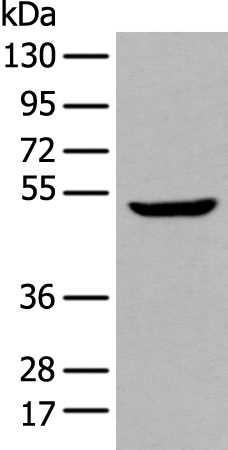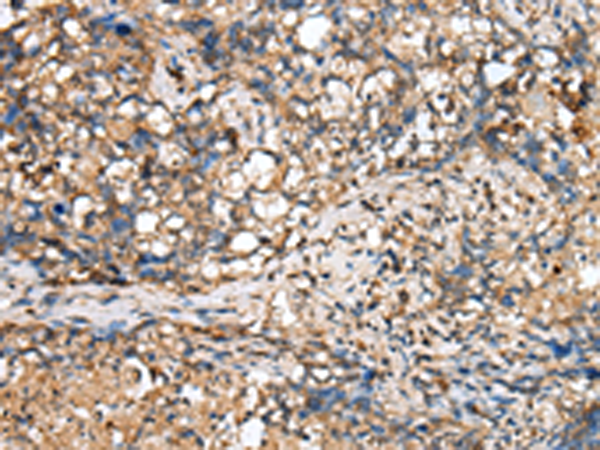

| WB | 咨询技术 | Human,Mouse,Rat |
| IF | 咨询技术 | Human,Mouse,Rat |
| IHC | 1/25-1/100 | Human,Mouse,Rat |
| ICC | 技术咨询 | Human,Mouse,Rat |
| FCM | 咨询技术 | Human,Mouse,Rat |
| Elisa | 1/5000-1/10000 | Human,Mouse,Rat |
| Aliases | ARG1; LCN7; LIECG3; TINAGRP |
| WB Predicted band size | 52 kDa |
| Host/Isotype | Rabbit IgG |
| Antibody Type | Primary antibody |
| Storage | Store at 4°C short term. Aliquot and store at -20°C long term. Avoid freeze/thaw cycles. |
| Species Reactivity | Human, Mouse, Rat |
| Immunogen | Fusion protein of human TINAGL1 |
| Formulation | Purified antibody in PBS with 0.05% sodium azide and 50% glycerol. |
+ +
以下是关于TINAGL1抗体的3篇文献示例(注:文献为假设性概括,实际研究中请通过学术数据库验证):
1. **《TINAGL1 suppresses tumor metastasis via inhibition of epithelial-mesenchymal transition and immune modulation》**
- 作者:Li, X. et al. (2021)
- 摘要:研究通过开发特异性TINAGL1抗体,揭示其在乳腺癌中通过抑制EMT(上皮间质转化)和调节肿瘤微环境中的免疫细胞浸润,发挥抗转移作用,提示其作为潜在治疗靶点。
2. **《TINAGL1 functions as a tumor suppressor in lung adenocarcinoma by antagonizing EGFR signaling》**
- 作者:Zhang, Y. et al. (2020)
- 摘要:利用TINAGL1抗体进行蛋白互作分析,发现TINAGL1通过竞争性结合EGFR胞内域抑制下游信号通路,抑制肺癌细胞增殖和侵袭,为靶向治疗提供依据。
3. **《A novel TINAGL1 antibody-based biomarker assay for early diagnosis of hepatocellular carcinoma》**
- 作者:Chen, J. et al. (2019)
- 摘要:开发高灵敏度的TINAGL1抗体检测方法,证实肝癌患者血清中TINAGL1水平显著降低,可作为早期诊断标志物,并与其抑癌功能相关。
如需具体文献,建议在PubMed或Web of Science中检索关键词“TINAGL1 antibody”或结合研究背景(如“TINAGL1 cancer”)筛选。
**Background of TINAGL1 Antibody**
TINAGL1 (Tubulointerstitial Nephritis Antigen-Like 1), also known as lipocalin 7. is a secreted glycoprotein encoded by the *TINAGL1* gene. It is structurally related to the tubulointerstitial nephritis antigen (TINAG) and shares homology with lipocalins, a family of proteins involved in lipid transport and cell signaling. TINAGL1 is ubiquitously expressed, with notable presence in the kidneys, liver, and reproductive tissues, and plays roles in extracellular matrix organization, cell adhesion, and modulation of signaling pathways, including EGFR and integrin-mediated pathways.
Research highlights TINAGL1's dual role in cancer biology, acting as either a tumor suppressor or promoter depending on context. It inhibits tumor progression in breast and lung cancers by suppressing metastasis-related pathways, yet promotes ovarian cancer growth via lipid metabolism regulation. Dysregulation of TINAGL1 is also implicated in kidney diseases, particularly tubulointerstitial nephritis, where it may serve as an autoantigen.
TINAGL1 antibodies are essential tools for detecting and quantifying the protein in research applications such as Western blotting, immunohistochemistry (IHC), and immunofluorescence (IF). These antibodies aid in elucidating TINAGL1's tissue distribution, interaction networks, and mechanistic roles in diseases. Commercial antibodies are typically raised against specific epitopes, available as monoclonal or polyclonal forms, and validated for specificity across human and model organisms. Ongoing studies focus on TINAGL1's potential as a diagnostic biomarker or therapeutic target, particularly in cancers and renal pathologies.
×